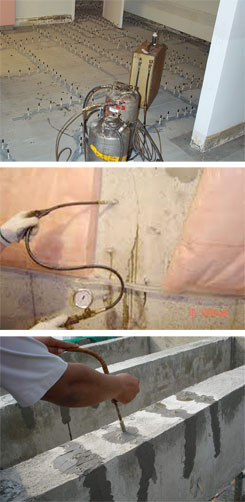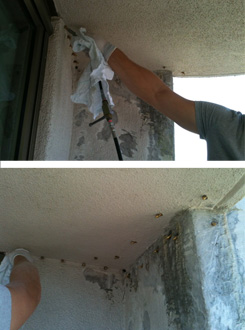


- Waterproofing Solutions
- Concrete Repairs
- Crack Injections
- Remedial Repairs



- Waterproofing Solutions
- Concrete Repairs
- Crack Injections
- Remedial Repairs



- Waterproofing Solutions
- Concrete Repairs
- Crack Injections
- Remedial Repairs

While concrete cracks appear to be typical, it is not recommended that they remain ignored. Most homeowners best identify concrete cracks in their basement, either on the foundation wall or on the floor. They may also recognize cracks on the garage floor, patio or in-ground pool.
These cracks, typically due to drying shrinkage, thermal movement or other causes usually are minor and result in few problems. More often than not, a foundation crack will widen over time and result in water seepage or possibly the loss of structural integrity. Foundation and slab cracks are not only an eyesore, but they may hinder the value of the home.
Fortunately, there is an easy way to permanently repair such cracks without the need for costly and disruptive excavation or drain tile. Poured foundation cracks may be repaired by using low-pressure injection of an epoxy or polyurethane foam material. For the repair of concrete floor cracks, certain epoxies and polyurea materials exists, suitable for such slab repairs.
The application of such materials may be completed by a basement waterproofing contractor or a do-it-yourself homeowner. Either way, the repair of concrete cracks in either the foundation or the slab may efficiently and effectively be completed in as little as an hour or more.
On discovering a crack in your concrete building you may be tempted to think that the structure is about to collapse. You may have many questions to which there seems to be no answers. Concrete Renovations intend to provide you with some basic reasons as to why concrete cracks and answer some of your questions.
Most cracks occur as a result of shrinkage of concrete. Shrinkage is simply a reduction in the volume of concrete as it hardens. If this reduction in volume were unrestricted, then a crack would not occur. However, in reality, ground friction and a number of things such as structural connections inhibit free shrinkage and thus cause cracks.
A 30 metre long regular-weight concrete slab normally would shrink by about 18mm. In other words, you should expect cracks totaling in widths up to 18mm in every 30 metres of concrete. Lightweight concrete shrinks more. It is important to note that concrete does crack and that this is normal. What is not normal is an unsightly and excessive amount of cracks.
Not every crack threatens the structural safety of a building. In fact, in many instances, cracks are merely cosmetic in nature. These cracks are typically seen in flat work such as walkways and curbs.
Typical causes of these cracks are:
Sometimes such nonstructural cracks in driveways and paths become more than just an eyesore. Tree roots and impact from vehicles can cause raveling as well as vertical and horizontal offsets at the cracks.
When these offsets become trip hazards, repairs are necessary.
A majority of structural cracks occur as a result of the following conditions:

Sometimes structural cracks manifest themselves with some side effects:
Major cracks in concrete, stone and masonry of up to 10mm are treated with our thixotropic anchor grout systems.